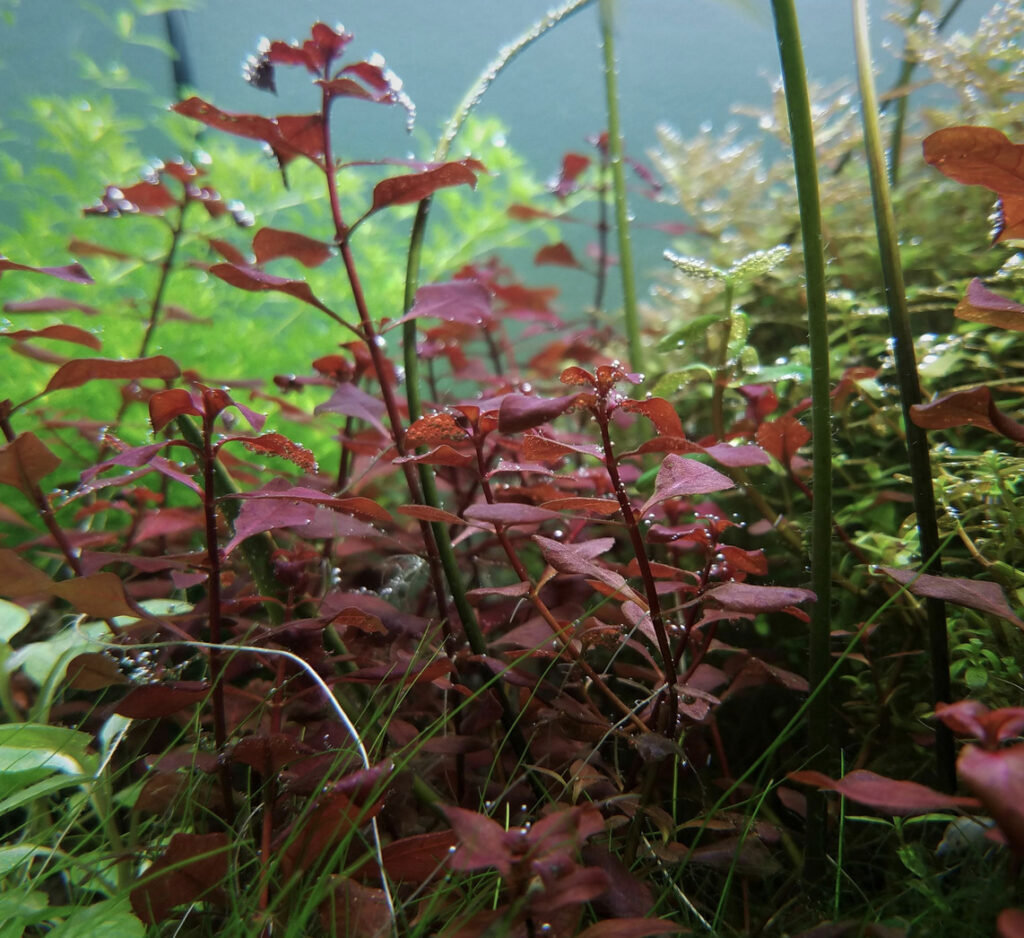
Smartplantedaquarium.com participates in affiliate marketing programs. We may earn commissions on purchases made through our affiliate links. This doesn't affect our content or recommendations and we only recommend products we would put in our own tanks.
Red Ludwigia, also known as Ludwigia Natans or by it’s sister: Ludwigia Repens is a sought after freshwater aquarium plant that will enhance your tank with it’s striking red leaves, ease of maintenance, and rapid growth. In this comprehensive guide, we’ll delve into every aspect of the Red Ludwigia family, from it’s varieties, origins, and we may even get lost in the weeds of planting and maintenance. Pun intended.
Whether you’re an expert aquascaper looking to liven up your tank, or a beginner hobbyist seeking a low-maintenance aquatic addition, join us on the journey to unlocking the secrets of the often underrated Red Ludwigia.
Contents
- Overview of Red Ludwigia
- Description and Appearance
- Origin
- Different Types of Ludwigia
- Size and Growth Rate of Ludwigia
- Benefits of Keeping Ludwigia in Your Tank
- Ideal Tank Setup and Conditions for Red Ludwigia
- How to Propagate Red Ludwigia
- How to Plant Red Ludwigia
- Red Ludwigia Plant Care Guide
- Compatible Tank Mates and Plants
- Conculsion
Overview of Red Ludwigia
Red Ludwigia is a popular aquatic plant species that belongs to the family Ludwigia repens. It is native to the Atlantic and Gulf regions of North America, particularly ranging from the United States to as far south as El Salvador. This plant is widely used in the aquarium hobby due to its hardiness, attractive appearance, and ease of care.
Certainly that’s not all you should know about this wonderful plant. Below are several more details in the table to provide you with more of a comprehensive overview of Red Ludwigia, it’s origin story and what it requires to thrive in your tank. Take a look at the table to find out:
| Feature | Description |
| Scientific name(s) | Ludwigia repens |
| Common name | Creeping primrose-willow |
| Family | Onagraceae |
| Genus | Ludwigia |
| Origin | US and Mexico |
| Habitat | USA, Mexico, and to nothern South America |
| Growth rate | Fast |
| Difficulty level | Easy |
| Light requirements | Low to medium |
| pH Range | 6.0 – 8.0 |
| Water Hardness | Soft to hard (Grows best in soft water) |
| Maximum Size | 20 inches |
| Plant Type | Freshwater marsh plant |
| Leaf Type | Oval-shaped, Elliptic |
| Leaf Color | Green to bright red |
| Leaf Texture | Waxy |
| Placement | Mid to background |
| Substrate | Nutrient rich |
| CO2 Requirement | Low to none |
| Propagation | Cut off the top of the shoots |
| Growth Habit | Prefers nutrient rich substrate, but can be planted on hardscapes. |
| Tank Size | 20 gallon and up |
| Tankmates | Carnivorous fish, Java Fern, Amazon Sword, and the Rotala Rotundifolia |
| Algae Susceptibility | Low |
| Special Considerations | – Quarantine Red Ludwigia first before inserting it into your tank. It has been reported that they may contain snails, bacteria, and predators like the dragon fly nymphs. – Consider using in vitro pot transplant to avoid contamination |
| Common Uses | – Ludwigia Repens provides a helpful shelter for fish tank residents. – Ludwigia’s can remove excess nutrients and level out aquarium nitrate readings. – A stunning and colorful addition to all aquariums due to its bright red hues. |
| Temperature | 20 – 28 °C (68 – 82 °F) |
Description and Appearance
Red Ludwigia is a striking red-leafed aquarium plant that can energize any tank. For the majority of this guide we will be refering to the Ludwigia Repens and the Red Ludwigia aka the Ludwigia Natans Super Red. Please note that Ludwigia has several sister species each of which can have colorings of green, red, orange, and even white.
Some Ludwigia species even have long and thin leaves such as the Ludwigia Arcuata. While others have thicker, spade-shaped leaves like Ludwigia Repens. Regardless of tank size and layout, there will be a Ludwigia species to match the vibe you’re hunting for.
Origin
Known as the Creeping Primrose-willow, the Red Ludwigia is an aquatic trailing plant found in the tropical waters of North America and Mexico. It grows rapidly in shallow waters of streams, lakes, ponds, and culverts. Due to it’s fast growth, it can be considered a pest species, however, a fast growing plant can be a boon for aquarium hobbyists.
It hails from the Family: Onagraceae – and it gets the name “Ludwigia” from a Swedish botanist and zoologist who named it after the older German botanist Gottlieb Ludwig. They don’t call it a Creeping Primrose-willow for nothing; the Ludwigia is a mat-forming perennial herb with a stem that can crawl out over 30 centimetres to root with nutrient rich substrate.
Different Types of Ludwigia
There are many types of Ludwigia commonly found in the aquarium hobby. All of which are beginner friendly, have similar growth tendencies, and will add excitement to your tank. The main three types are Ludwigia Sp. Red Mini aka “Super Red”, Ludwigia Repens, and Lidwigia Ovalis. Below are detailed notes on each of the most common Ludwigia species aquarium hobbyists are known to add.
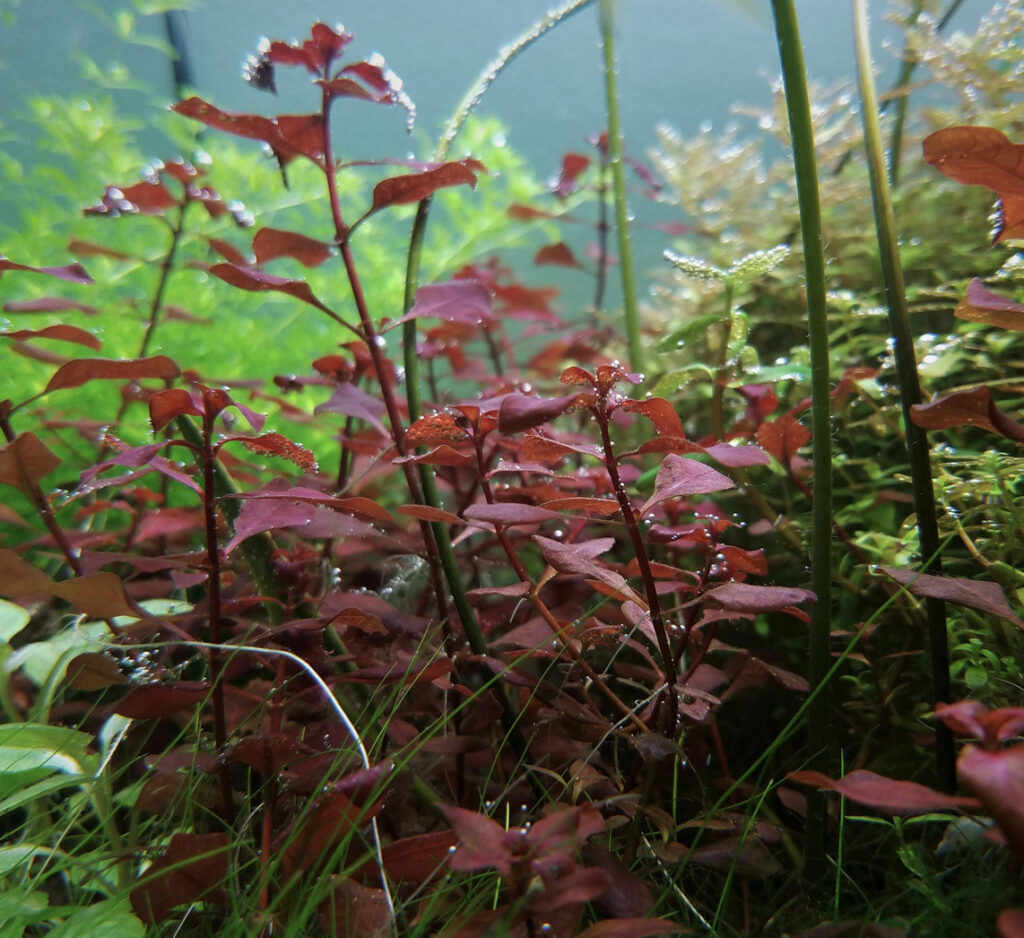
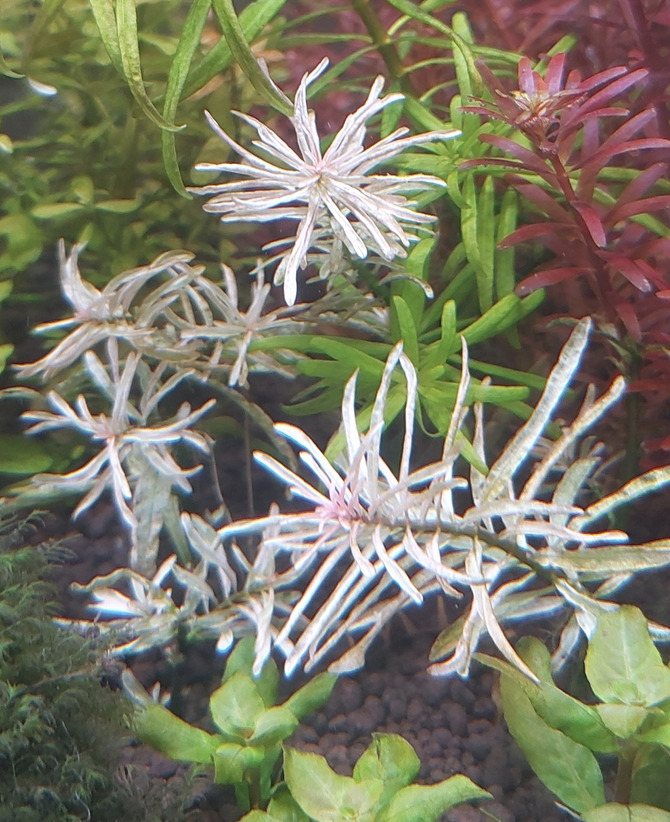
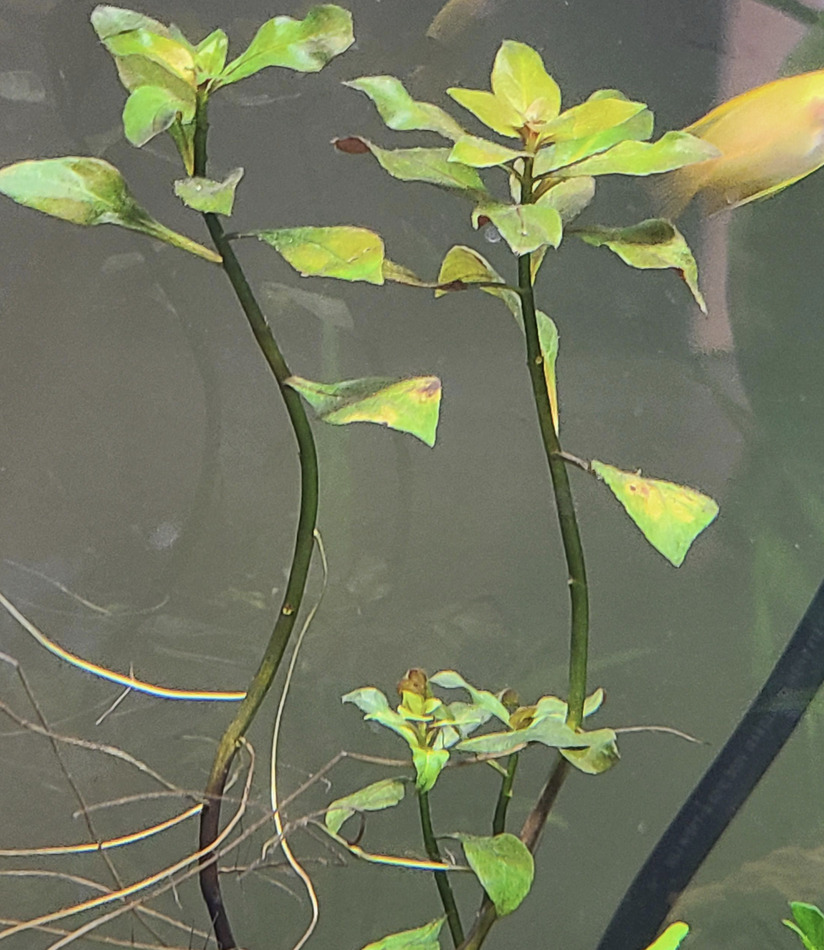
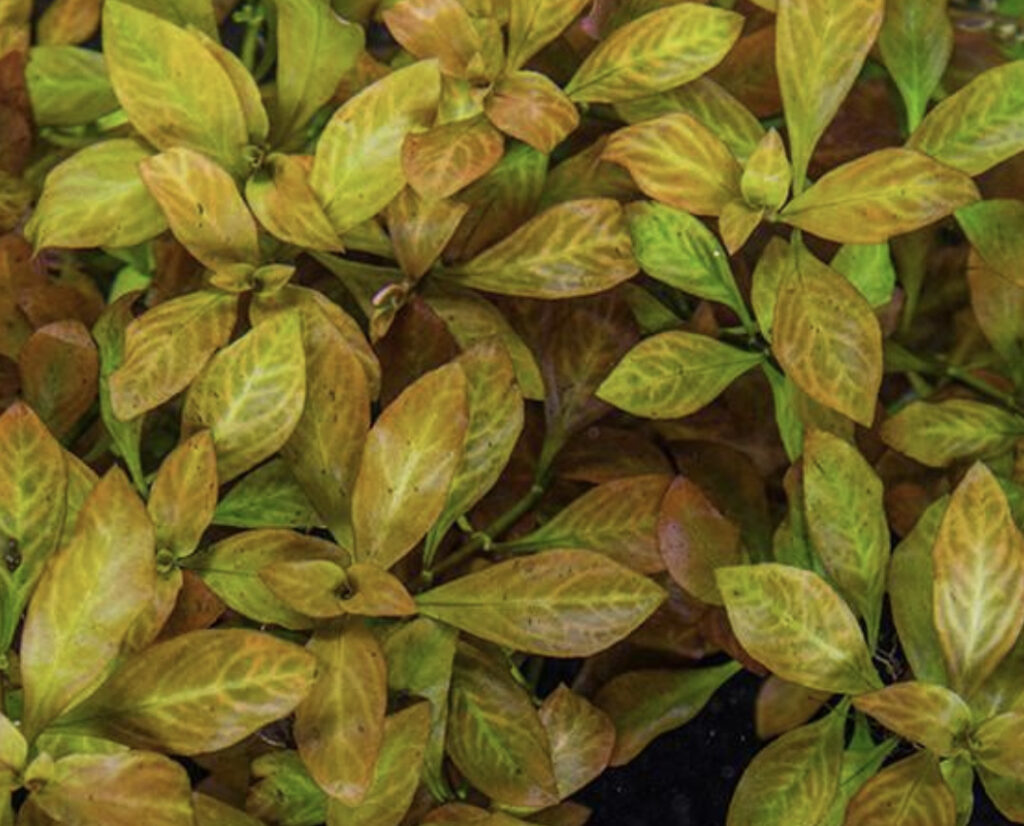
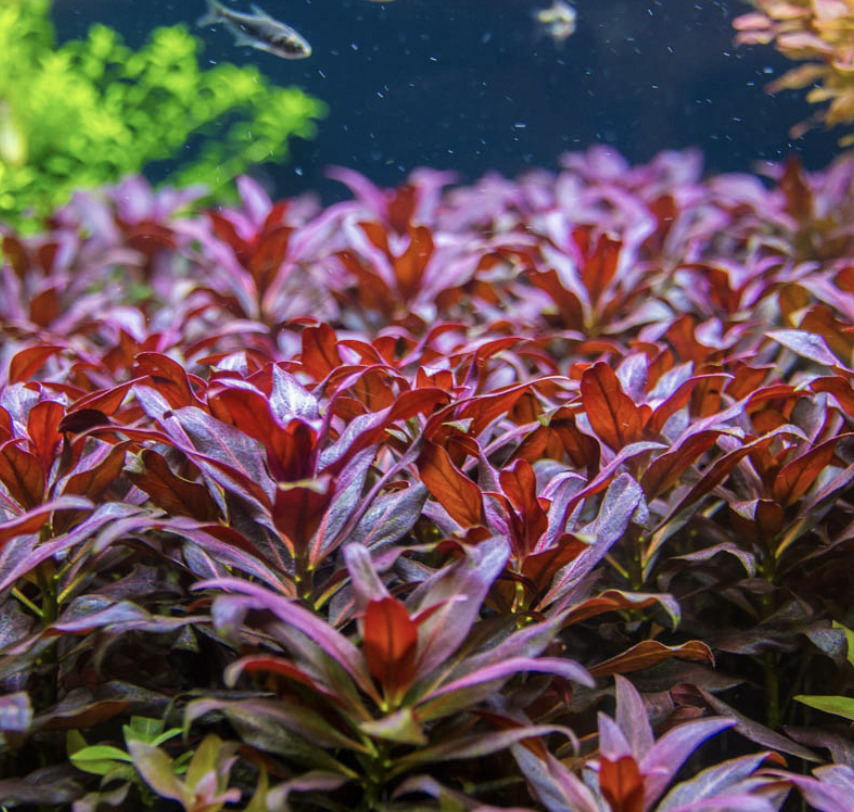
Ludwigia Repens: The Repens is the most purchased Ludwigia species in the hobby. It’s ease of care, the potential to propagate, and it’s fast growth make it a key starter plant for anyone’s aquarium. Furthermore, this species has both green and red leaves which provides a unique look to your aquascape.
Ludwigia Sp. Mini / Super Red: If you’re looking for a splash of bright red in your tank, look no further than Ludwigia Sp. Super Red. This species is specifically bred for it’s bright red hues and will be sure to enhance your tank’s color scheme. It doesn’t grow as big as some of it’s brothers, but it makes it up with it’s bushy, compact, and resistance to nibbling fish.
Ludwigia Ovalis: The Ovalis is a variant of the Ludwigia family characterized by it’s broad leaves which can range from green, white, and rose-colored. It often grows wider than it’s counterparts making it an economic option for those who would like to maximum plant cover for the price.
Ludwigia Glandulosa: If you’re looking for a darker shade of red in your tank, the Ludwigia Glandulosa is the right fit for you. This species is little more slow-growing and will demand a more nutrient rich substrate to keep it healthy. However it’s beautiful dark red leaves and and bushy stature makes up for it’s picky needs.
Ludwigia White: This type of Ludwigia is rarer and more expensive than it’s red and green counterparts. However it’s high cost and hard-to-find nature is more than made up for with its strikingly long, thin, and wispy white leaves dancing inside your aquarium.
Size and Growth Rate of Ludwigia
The size and growth rate of any Ludwigia species depends on the variety, water conditions, substrate, and lighting. Below is a general outline of the size and growth rate you can expect when growing Ludwigia in your tank.
Size:
- The Ludwigia Repens can grow to 20 – 40cm + after 2 months of growth in the ideal aquarium habitat.
- This species will often grow out of the tank, and can survive both submerged or emerged.
Growth Rate:
- Compared to other plants, the Ludwigia has a medium growth rate. Some sister species such as the Ludwigia Glandulosa grow slower than the Ludwigia Repens.
- Consider trimming shoots to promote new growth and enhance the density of the plant.
Influencing Factors:
- Lighting: To get the desired bright red colors, you will need to provide your Ludwigia with a lot of lighting. The more lighting you give your Ludwigia the redder the leaves will become. Whereas a lesser amount of light will turn them greener.
- Nutrients: Ludwigia can benefit from a dosing of CO2, micronutrients, and fertilizers with iron to enhance growth and coloration.
- Water hardness: Soft and slightly acidic water provides the best growing conditions.
Benefits of Keeping Ludwigia in Your Tank
There are several bonuses to keeping the beautiful Red Ludwigia in your tank many of which go beyond their lovely coloring. One of the Ludwigia’s primary benefits is it’s ease of care. The caring for your Ludwigia plants is breeze. They don’t require high levels of CO2, they can thrive in many different water parameters from hard to soft, and they’re easy to propagate by trimming and replanting their stems.
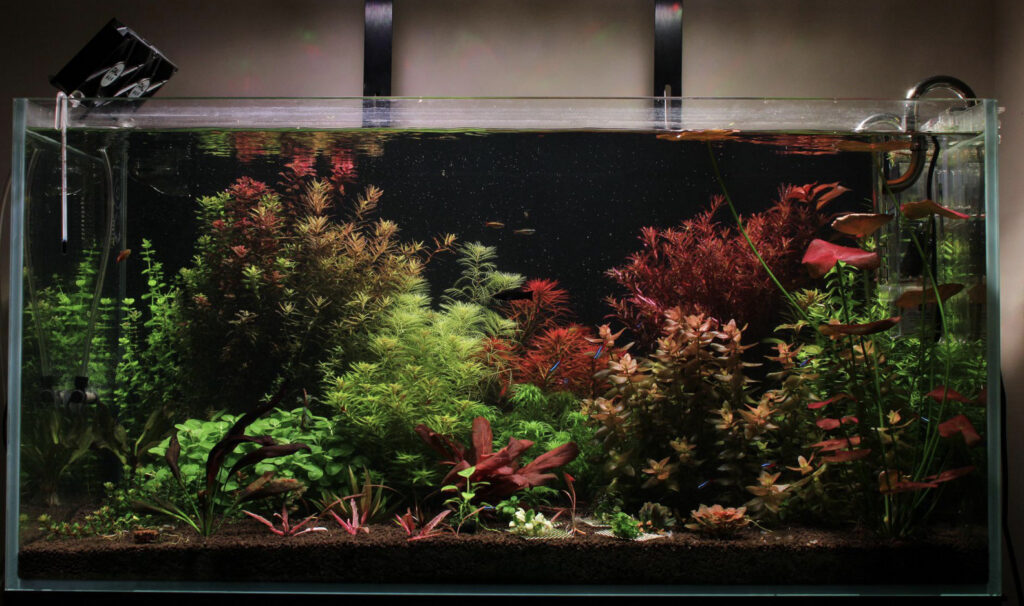
The dense foliage and ground cover offered by this species create a lovely playground for your aquatic pets while reinforcing the structure of your aquascape with its long-reaching root system. The Ludwigia family not only grows upwards but also, with careful pruning, spreads across the tank’s floor, offering a natural shield for your aquarium inhabitants. Its bushy growth provides numerous hideaways, fostering an environment where your fish life can flourish.
Ludwigia plays a dedicated role in your overall tank’s health. It’s known as a plant which absorbs excess nutrients like nitrogen and CO2 at high rates which helps play a critical role in keeping your water quality healthy. Red Ludwigias help maintain balance in any ecosystem with their phosphate and nitrate absorption abilities.
Ideal Tank Setup and Conditions for Red Ludwigia
The Ludwigia family is generally a hardy, versatile, and forgiving aquarium plant that can thrive in a variety of thank conditions. However, to ensure the best health, growth, and coloration, the following conditions and requirements should be considered:
Water Parameters: Red Ludwigia and Ludwigia Repens grow best in slightly acidic water but can survive in neutral to alkaline waters too. Softer water is preferred over hard. Due to it’s tropical origins, the Ludwigia prefers a water temperature of 75 – 80°F but can grow in much cooler waters albeit at slower rates.
Lighting: The Red Ludwigia enjoys moderate to strong aquarium lighting for at least 6 – 8 hours per day. Light strenght of 200 to 300 PAR (Photosynthetically Active Radiation).
Substrate: Furthermore, as a species which can take in nutrients from both the water column and the substrate, a high-quality aquatic soil or ‘active substrate‘ is ideal for this species.
Nutrients: The Ludwigia species requires a healthy dosing of nutrients to reach it’s full potential. An iron supplement added in small amounts will help bring out it’s red leaves. You will also need to give it a moderate injection of 30ppm of CO2 in the morning to spur it’s growth.
How to Propagate Red Ludwigia
Propagating Red Ludwigia is relatively straightforward and can be done through taking cuttings of Ludwigia shoots and planting them back in well-lit area of your substrate. This type of propagation is called ‘Vegetative Propagation’. Here’s a step-by-step guide on how to propagate Ludwigia Repens and it’s sister species:
- Step 1 – Select Healthy Stem: To identify the healthiest stem possible select a stem with aerial root growth coming out the sides of the main stem. Cut slightly below these aerial roots but still above the next stem node. The goal is to have these starting aerial roots become the next planted roots when you transplant the clipping.
- Step 2 – Remove Bottom Leaves: Before planting, take your scissors and remove the bottom leaves and branches. Make sure to leave the aerial roots we mentioned before intact. Removing these leaves is essential as they will rot if left inside the substrate.
- Step 3 – Insert and Place in Substrate: Pinching the very end of the stem with your aquarium tweezers, plant it inside the substrate. Usually 1 – 2 inches away from any plants will suffice due to their moderate sized root structure. Be delicate, patient, and don’t worry if they’re slumped over – in a few weeks they’ll be growing towards the light source.
- Step 4 – Maintain and Monitor: Propagating Ludwigia can be stressful and cause damage to your specimens. During the propagation process trim off any dying leaves and manage it’s plant growth to ensure a healthy and balanced aquarium environment.
How to Plant Red Ludwigia
Planting Ludwigia Repens is straightforward due to its versatility, hardiness and popularity as a stem plant. Here’s a detailed step-by-step guide on how to plant Red Ludwigia and related species in your aquarium:
Step 1 – Preparation
When you’ve purchased your Red Ludwigia plants they’ll come in a bundle with an elastic wrapped around the bottom of their stems. The first step to preparing these them is to cut them free from the elastic band and separate them for inspection. Be sure not to cut off any of their root structure as that will lengthen the time it takes them to grow.
Step 2 – Inspection and Quarantine
Unless it’s been grown in a laboratory, It’s critical to inspect the Red Ludwigia for any unwanted critters that could be hiding among it’s leaves. Invertebrates such as snails and dragonfly nymphs have been found on these plants and caused destruction. To avoid this outcome, lay each of your Red Ludwigia stems out on a paper towel and preform a visual inspection. Trim off any damaged leaves, and check for any eggs or insects hiding. It’s critical not to add any new plants to your tank right after you bought them. Instead add these new plants to a quarantine tank where you can disinfect it from pesticides and other invertebrates.
Step 3 – Placement
Once your Red Ludwigia has passed the 2-week quarantine, you can plant it in your main tank. To get the right placement, use your extra long aquarium tweezers to grab the base of the stem and insert it firmly into your main tank’s substrate. To achieve the best growth results, plant each stem by 1 – 2 inches ( 2.5cm – 5cm) apart and 1 inch (2.5cm) deep. Red Ludwigia looks best in the mid-ground to background of your tank, in fact, many people also use Red Ludwigia to highlight the focal points of their aquascapes.
Step 4 – Maintenance
The Red Ludwigia is a steady grower and easy to maintain. However, due to it’s steady growth rate, you will have to perform upkeep to ensure they’re looking their best. To do this you can trim your Red Ludwigia’s lateral shoots when they sprout outwards with aquarium scissors. Repeat pruning them and you will have a beautiful, bushy Red Ludwigia in a month or less. You can also replant those shoots from your pruning endeavors elsewhere in your tank to maximize value out of your plant. Furthermore, you can also take this time to sheer off dead, broken, or discolored leaves too.
A general rule of thumb when growing Red Ludwigia is that less light will give them a taller and more slender look, while access to more light will stimulate a bushier, thicker, and redder growth. If you want to ensure you have red on your Ludwigia species, make sure to leave the lights on for 6 – 8 hours per day. Furthermore, you can stimulate it’s growth and red leaves with a regular dosage of CO2 and any aquatic fertilizers containing iron.
Red Ludwigia Plant Care Guide
Here’s how to take care and keep your Red Ludwigia and other Ludwigia species happy in your planted aquarium:
Algae Management: Ludwigia are susceptible to green algae build-up on their leaves which you must monitor. Check the leaves each week and trim off any that are overrun by green algae build up.
Disease Prevention: Always quarantine new plants before adding them to the main tank to prevent the introduction of diseases or pests. Use dechlorinated or distilled water for water changes to avoid introducing harmful chemicals or contaminants.
Fertilization: Being that the Ludwigia enjoys a moderate to high amount of nutrients, it’s key to provide a substrate or supplements that includes both macro and micro nutrients to meet the the Ludwigia’s nutritional needs.
Monitoring: Make sure to watch the plant’s growth rate, color, and root development. Based on observations, adjust light, nutrients, and water conditions to maintain optimal health.
Pruning and Trimming: The fast growth of the Ludwigia means a regular trimming schedule is necessary. With your aquarium scissors trim damaged leaves and lateral shoots to promote the growth and bushiness of this plant.
Compatible Tank Mates and Plants
Finding compatible tanks mates for your Ludwigia plants can be a balancing act. While Ludwigia plants play along nicely with their planted brothers such as Amazon Sword and Java Fern, there are some aquatic species which can harm this plant. While most fish will hide and play in your Ludwigia Repens, there are some that will play a little… too hard. Here are the compatible creatures and the leaf-shredding culprits:
Compatible Tank Mates:
- Community fish: Non-aggressive fish such as Tetras, Loaches, Zebra Danios Guppies, Mollies, Platies, and Rasboras
- Peaceful Cichlids: Angelfish and Discuss are okay
- Snails: Mystery snails, Trumpet snails, and Nerite snails will be fine
Non Compatible Tank Mates:
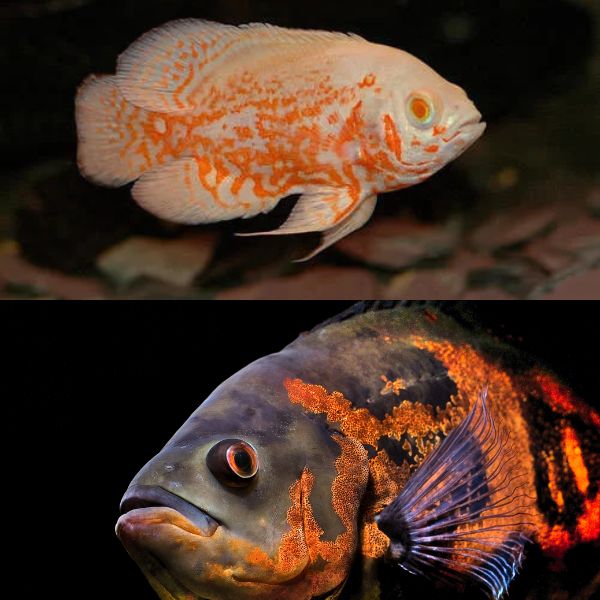
- Crayfish and Crabs: These species will snip off leaves and borough into root structures.
- Goldfish: Although the Ludwigia can handle minor nibbling from goldfish, but a large school of them will deteriorate the plant significantly.
- Oscars: These fish are too aggressive and will rip your Ludwigia apart or uproot them.
Conculsion
We’ve explored the fascinating world of the Ludwigia family – a hardy, fast-growing, and forgiving aquatic plant bound to make your tank the center of attention. With it’s diverse varieties and rich colors, the Ludwigia has become a mainstay for beginner and seasoned aquarists alike. By following the planting, propagation, and maintenance advice in this guide, you can ensure the the success of your Ludwigia and bet on this fauna flourishing across your tank.
The key to a thriving aquarium is not just the in the visual of the plant itself, but in the care and attention you provide it’s inhabitants. When you love your aquarium and provide it the attention it deserves, the ecosystems will thrive. Now, its time for you to propagate and enjoy the luscious red leaves of the Red Ludwigia as it charges your aquascape and injects energy into your tank.
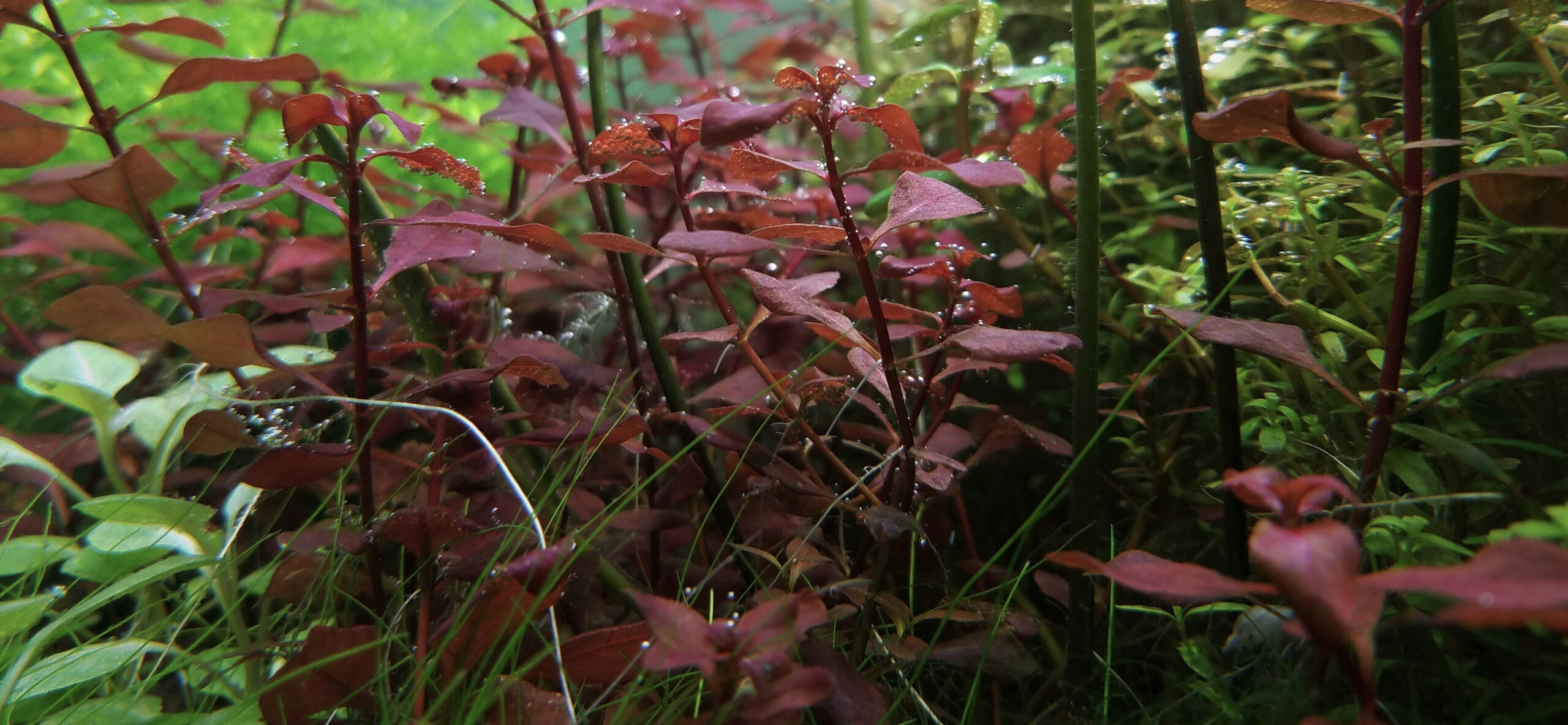
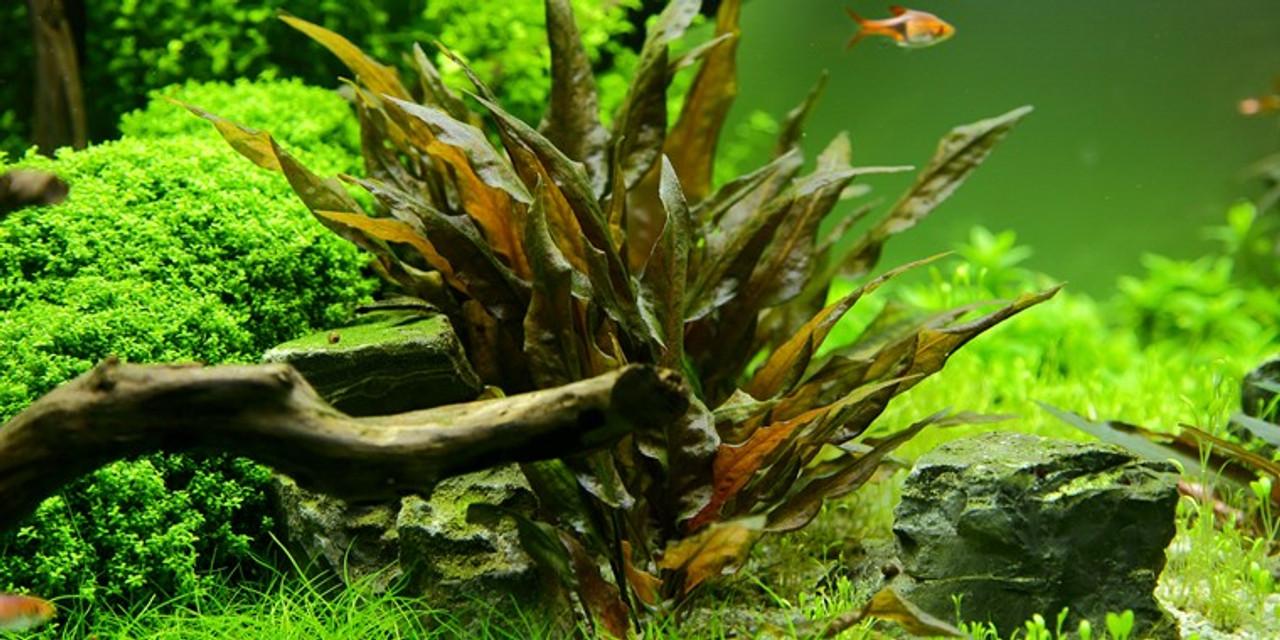
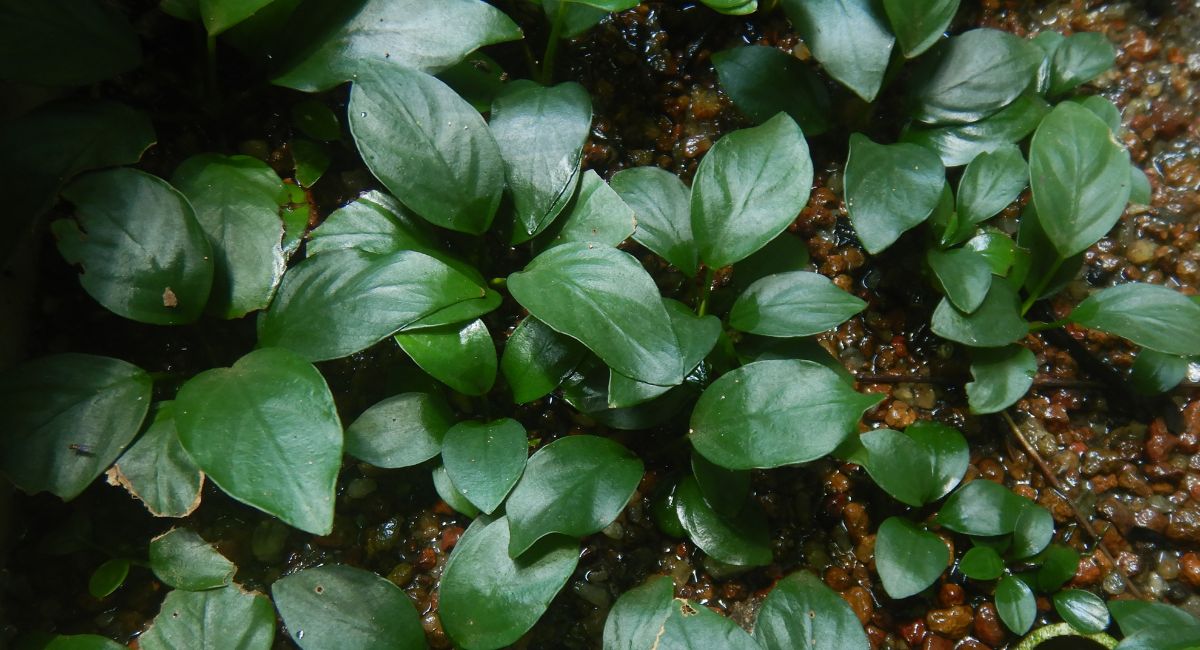


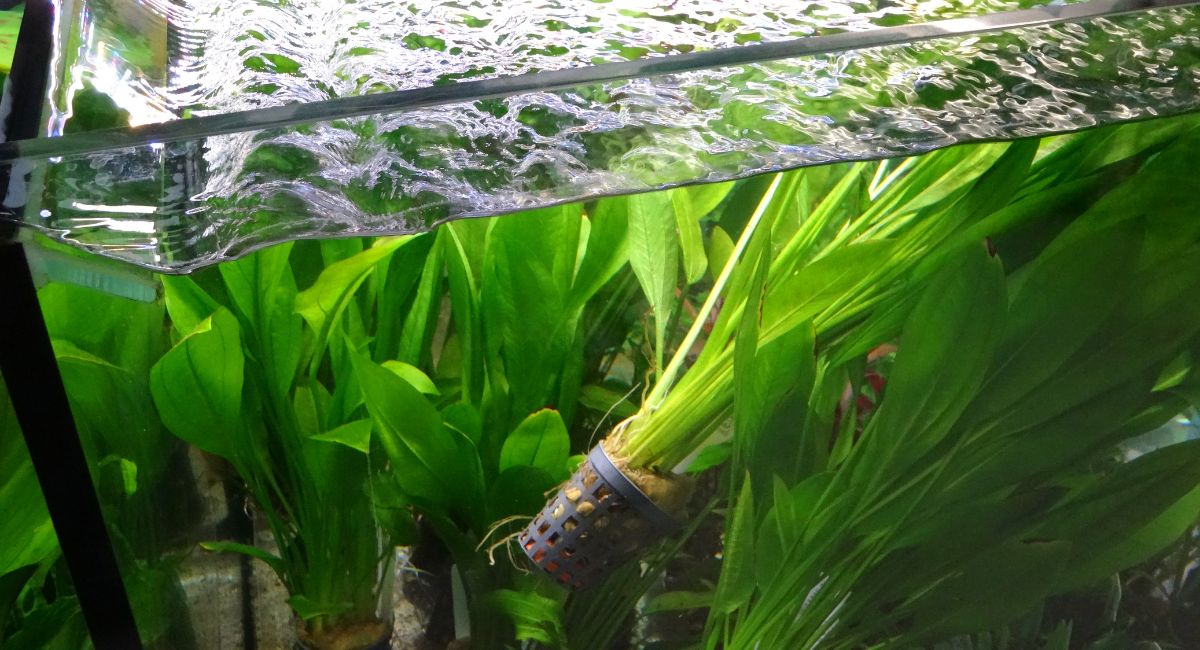
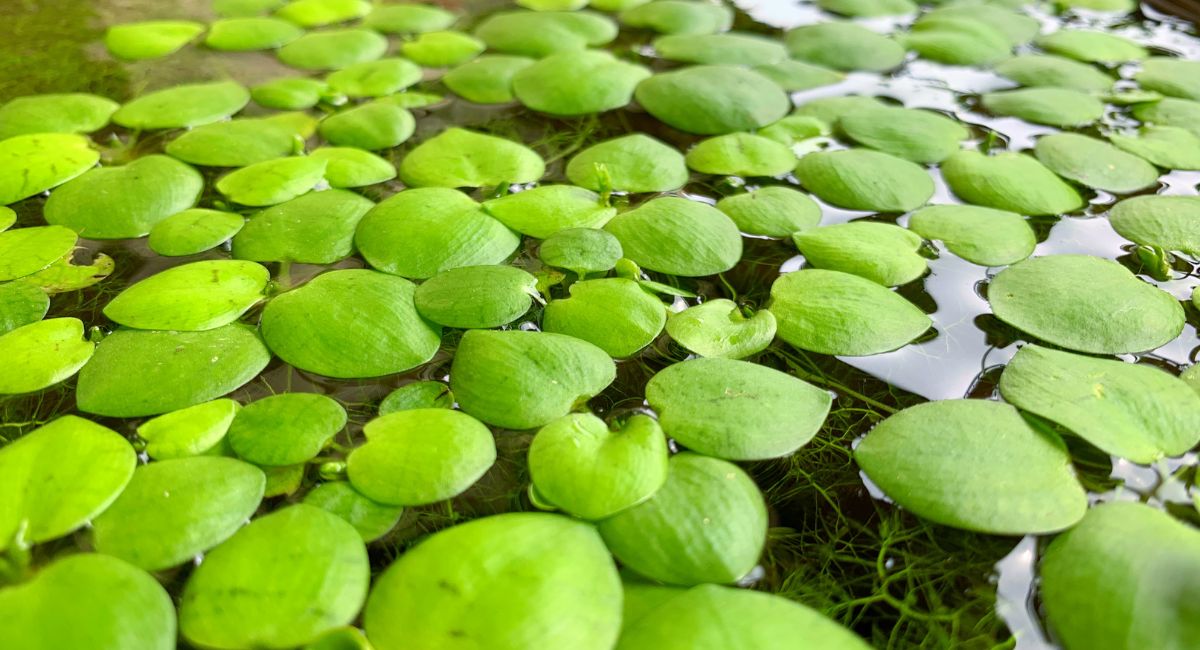
Probably the best article I’ve read to date on this aquarium plant. Thank you.